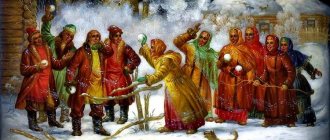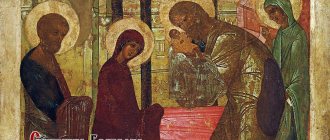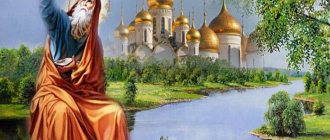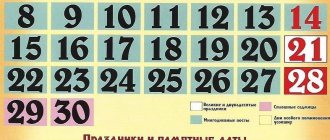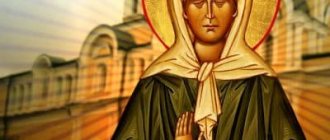The Resurrection of Christ is over, but for some reason believers continue to greet: “Christ is risen!” How many days is Easter celebrated?
Major Orthodox holidays have days of pre-celebration and post-celebration - the period before and after the holiday itself, when its echoes are heard in the service.
The celebration of Easter, the main Christian holiday, is the longest, lasting 38 days. Taking into account the day of the holiday and the day of sacrifice, Orthodox Christians celebrate Easter for 40 days. The Savior stayed on earth for so long before His ascension. The first week after Easter, Bright Week, stands out from this period.
On all days of this holiday we greet each other with the words “Christ is Risen!” - “Truly he is risen!”, with which we profess faith in the resurrection of the Lord, we exchange red eggs, which symbolize new life.
The word "Passover" in Hebrew means "deliverance." Christian New Testament Easter is the day on which our transition from death to incorruptible life, from earth to Heaven took place. With His resurrection, the Lord opened the gates of heaven to people and gave them great joy and hope.
The Savior rose on the night of the third day after death on the cross, Himself, by the power of His Divinity. At night the earth shook, an angel came down from heaven and rolled away the stone from the door of the tomb-cave.
At dawn, the women, taking with them fragrant myrrh, went to the tomb to anoint the body of the deceased Savior. They saw the stone rolled away from the door of the tomb, and the angels who announced to them about the resurrection of Christ. The myrrh-bearers hastily told the apostles about this, but they did not believe it.
However, John and Peter still ran to the tomb and saw folded funeral clothes in the empty tomb. When the weeping Mary Magdalene came to the tomb, the risen Christ appeared to her. On the same day, other myrrh-bearers, Peter, the Evangelist Luke, and other apostles, except Thomas, saw Him. But first of all, according to Sacred Tradition, the risen Jesus appeared to His Most Pure Mother.
So:
- the celebration lasts seven days or eight, if you count all the days of the continuous celebration of Easter until Fomin Monday, through Fomin Sunday inclusive;
- At the end of Easter week, the Church continues to celebrate Easter, but with less solemnity, until the Ascension of the Lord, i.e. 32 more days;
- the total number of days of Easter celebration is 40 - exactly as many as Christ appeared to His disciples after the Resurrection.
- Related Posts
- Kuglof recipe for yeast cake for Easter
- Easter cake recipe for Kenwood bread machines
- How to blow an egg for crafts
« Previous entry
How long does Easter 2021 last - the beginning and end of the holiday
According to Orthodox traditions, many holidays have special days of pre-celebration and post-celebration, during which services in churches are held in a special order. It is generally accepted that significant church holidays last not one, but several days.
The duration of the Easter period is 40 days - in 2021, Easter begins on May 2 and ends on June 9 .
Sometimes you can hear the version that the number of holidays is 38, but this is not entirely true. This difference is due to confusion in the methods of calculation. Correctly, the duration of the Easter period must be calculated taking into account the days of Easter itself and the day of the Ascension of the Lord (the first and last days of the Easter festivities), which some Orthodox people forget.
Throughout the 40 days, it is customary to glorify the Resurrection of the Savior, make Christ and attend services in the temple. The number 40 is deeply symbolic for Christians, since this is exactly how much time has passed since the Resurrection of Christ and until his Ascension into heaven, to the Father.
Easter festivities can be divided into several main periods:
- Easter,
- Bright Week,
- Fomina week,
- the period from the beginning of the Week of the Myrrh-Bearing Women until the Ascension of the Lord.
In 2021, Easter is celebrated on May 2. Easter festivities continue until June 9.
Easter and its predecessor Lent
When discussing such a holiday, one cannot help but pay attention to fasting. People who adhere to Christian traditions do not share all these periods - Lent and Easter. In Russia, the Easter holidays last 40 days, and Lent lasts 56 days - that's 8 weeks, each of which has a specific meaning and rules of observance in nutrition, repentance and celebration.
Important! This is a moving holiday that includes memorable dates. Most of them are called weeks, which in Christianity are considered Sundays. The post includes a week:
- Orthodox celebration;
- Gregory Palamas (saint);
- Life-giving Cross (cross veneration);
- John Climacus (saint);
- Mary of Egypt (venerable);
- the appearance of the Lord in Jerusalem (resurrection - Palm);
- Holy Week, from Sunday of which Easter is celebrated for 40 days.
The period of fasting includes two more Saturdays - Akathist Saturday and Lazarus Saturday. These are two special dates during the Lent period, dedicated to certain events in the history of Christianity.
Why does the date of Easter change every year?
Easter can fall on any Sunday from April 4 to May 8 according to the new style, since this holiday does not have a fixed date.
Easter Day directly depends on the lunisolar calendar and is tied to the spring full moon, the first after the spring equinox. In turn, the absence of a fixed date for this natural phenomenon is easy to explain from a scientific point of view. A lunar month is much shorter than a month according to the solar calendar. As a result, a lag of one and a half weeks accumulates over the calendar year, so new moons and full moons do not have constant dates from year to year.
When calculating the date of Easter, the following are taken into account:
- dates of the vernal equinox,
- lunar and solar calendars,
- attachment to the Sunday day of the week.
Prototypes: “Earthly Easter”
“Observe the month of Abib (Nisan), and keep the Passover to the Lord your God, for in the month of Abib the Lord your God brought you out of Egypt by night” (Deuteronomy 16:1)
The historical and symbolic basis of the Jewish Passover is the epic events of the book of Exodus. It tells about the four-century period of Egyptian slavery, in which the Jewish people were oppressed by the pharaohs, and the wonderful drama of their liberation. Nine punishments (“plagues of Egypt”) were brought down on the country by the prophet Moses, but only the tenth made the cruel heart of the pharaoh soften, who did not want to lose the slaves who were building new cities for him. It was the defeat of the Egyptian firstborns, which was followed by the “exodus” from the House of Slavery. At night, while waiting for the exodus to begin, the Israelites eat their first Passover meal. The head of each family, having slaughtered a one-year-old lamb (lamb or kid), anoints the doorposts with its blood (Ex. 12:11), and the animal itself, baked on the fire, is eaten, but so that its bones are not broken.
“Eat it this way: let your loins be girded, your sandals on your feet, and your staffs in your hands, and eat it with haste: this is the Passover of the Lord. And this very night I will walk through the land of Egypt and will strike every firstborn in the land of Egypt, from man to beast, and will bring judgment on all the gods of Egypt. I am the Lord. And your blood will be a sign on the houses where you are; and I will see the blood and pass by you, and there will be no destructive plague among you when I strike the land of Egypt” (Ex. 12:11-13).
So on the night of the first spring full moon (from the 14th/15th month of Abib, or Nisan) in the 2nd half of the 13th century before the birth of Christ, the exodus of the Israelites from Egypt took place, which became the most important event in Old Testament history. And Easter, which coincided with deliverance, became an annual holiday - a remembrance of the exodus. The very name “Passover” (Heb. Pesah - “passing”, “mercy”) indicates that dramatic moment (“tenth plague”) when the angel of the Lord who struck Egypt, seeing the blood of the Passover lamb on the doorposts of Jewish houses, passed passed by and spared the firstborn of Israel (Ex. 12:13).
Subsequently, the historical character of Easter began to be expressed by special prayers and a story about its events, as well as a ritual meal consisting of lamb meat, bitter herbs and sweet salad, which symbolizes the bitterness of Egyptian slavery and the sweetness of newfound freedom. Unleavened bread reminds us of hasty preparations. Four cups of wine accompany the Easter meal at home.
The night of the exodus became the second birth of the Israeli people, the beginning of its independent history. The final salvation of the world and victory over the “spiritual slavery of Egypt” will be accomplished in the future by God’s Anointed One from the line of King David - the Messiah, or, in Greek, Christ. This is how all the biblical kings were called at first, but the question of who would be the last in their ranks remained open. Therefore, every Passover night the Israelites waited for the appearance of the Messiah.
Easter Orthodox Traditions
Easter is one of the oldest holidays, which has its own centuries-old traditions.
Easter service
It is customary for Orthodox Christians to celebrate Easter in church. The most solemn service is Easter. It begins shortly before midnight: the Midnight Office is served, during which the Shroud is taken out and incense is performed around it, and subsequently the shrine is returned to the altar.
An obligatory stage of the festive service is the procession around the temple, marking the procession towards the risen Savior. The procession makes its way under the incessant ringing of church bells, which subsides only after the Orthodox, led by priests, approach the closed doors of the western entrance to the temple. After pronouncing certain words, the doors open and everyone enters the temple.
Around midnight, Easter Matins begins, which continues with the Divine Liturgy. The service usually lasts until 2-3 am and ends with the priests celebrating Christ with each other and with the parishioners.
In large churches with a huge flock, the priest usually only makes a speech, ending with the threefold phrase: “Christ is Risen!” This phrase encapsulates the entire essence of the Orthodox faith.
Christening
On Easter it is customary to greet each other in a special way. At the end of Matins, after singing “Let us embrace each other, shouting: brethren! and we will forgive all those who hate us through the resurrection,” the Orthodox say and answer each other: “Christ is Risen!” - “Truly He is Risen!”, after which they kiss three times on the cheeks.
This is the way you should greet each other throughout the next 40 days.
Easter meal
Immediately after the festive service, Orthodox Christians go to the refectory or to their home and begin to break their fast, that is, to eat foods prohibited during Lent. The central place on the table is occupied by a butter cake or paska, as it is commonly called in recent times. It is baked the day before, and at the end of the service it is consecrated in the temple. Initially, Easter was called cheese baba, for the preparation of which cottage cheese and a large number of chicken eggs were used.
Cottage cheese Easter has the shape of a truncated pyramid, symbolizing Mount Golgotha, on which the Savior was crucified. Eating Easter on this day represents the eternal victory of life over death, good over evil. Usually Orthodox Christians bring Easter, Easter cakes and eggs to the temple for consecration in wicker baskets decorated with colored ribbons, flowers, and Easter attributes.
Painted eggs
Painted eggs are a symbol of the Holy Sepulcher, which hides eternal life. The shell is the stone that was used to close the entrance to the rock where Jesus was buried, and the traditional red color, in which it was customary to paint eggs from time immemorial, is the personification of the suffering and shed blood of the Savior.
The origins of the tradition of giving eggs to each other originate in the New Testament. After the Resurrection, Christ appeared to Mary Magdalene, who reported the good news to the Apostles. She also appeared in Rome, where she spoke about the life, miracles and teachings of Christ to Tiberius himself, the Roman emperor. To prove the miracle of the Resurrection to the unbelieving ruler, Mary Magdalene took a white chicken egg in her hands and with the words “Christ is Risen!” handed it over, turning red in a matter of seconds, to the astonished Tiberius.
Painted eggs are a symbol of the Holy Sepulcher, which hides eternal life
Easter festivities
In Rus', it was customary to begin folk festivities immediately after visiting church. Dressed in their best, people did not hide their joy and good mood. Laughter and music were heard everywhere, fairs began to take place in the central squares, where brisk trade was carried out, and artisans demonstrated all their skills.
On this day, it is customary to engage in charity work: feeding the poor, giving things to orphans, leaving the homeless overnight.
In the evening, after sunset, it was customary to burn an Easter bonfire in central squares and streets, near churches and cemeteries, or right on the roads, symbolizing the victory of light over darkness, as well as the Light of God, enlightening all nations after the Resurrection of Christ.
Observing Easter traditions is a sacred matter for all Orthodox Christians. But without humility, kindness and mercy, even strict adherence to all canons will be a waste. Remembering the life of Christ and following him are the main indicators of a true believer.
EASTER or CHRIST'S RESURRECTION?
- Prototypes: “Earthly Easter”
- Performance: “Heavenly Easter”
- Easter is a forty-day holiday
It would seem that the meaning of Easter - as we usually call our main holiday - is quite transparent. Alas! Experience tells a different story. I will give only two of the most typical examples.
A lesson in one “Orthodox gymnasium”. Wanting to identify the level of knowledge of the children, I ask: “How did Christ and the apostles celebrate Easter?” – A reasonable answer follows: “They ate Easter cakes and colored eggs”! There is nothing to object to this! What about the adults?
Easter night breaking of fasts in one church. Indeed, we eat eggs and Easter cakes (and not only). “Suddenly” an important thought occurs to one already middle-aged singer, and he turns in confusion to the priest (with a theological education). “Father! So we keep singing and singing “Christ is Risen!”, and call the holiday “Easter”! So, after all, Jews celebrate Easter, but do not believe in Christ at all! Why is that?!"
This is no exception: what we perceive from childhood on an everyday level as some kind of beautiful ritual seems to us to be self-evident and does not require study.
Let’s give ourselves an “Easter lesson” and ask: what associations does the Easter greeting “Christ is Risen!” give rise to in our minds? - “Truly he is risen!”
A night religious procession with candles, everyone will immediately answer, joyful singing and mutual kisses. Dishes familiar from childhood appear on the home table - red and painted eggs, rosy Easter cakes, vanilla-scented Easter cottage cheese.
Yes, but this is only the external attributes of the holiday, a thoughtful Christian will object. – And I want to know why our holiday of the Resurrection of Christ is usually called the Hebrew word “Easter”? What is the connection between Jewish and Christian Passover? Why did the Savior of the world, from whose birthday humanity begins to count the New Era, have to die and be resurrected? Couldn't the all-good God have established a New Union (Covenant) with people in a different way? What is the symbolism of our Easter services and holiday rituals?
At what point in the service on Saturday does Holy Day end and Easter begin?
On Saturday evening, usually an hour or half an hour before midnight, as the abbot decides, a pre-festive midnight office is celebrated in churches. Despite the fact that in separate manuals the sequence of this service is printed together with the celebration of Holy Pascha, according to the Charter, it also refers to the Lenten Triodion.
The vigil before Easter emphasizes the importance and significance of the expectations of the coming Triumph. At the same time, it recalls the vigil of the people of God (the sons of Israel) on the night before their departure from Egypt (we emphasize that the Old Testament Passover sacrifice, which prefigured the Sacrifice of Christ on the Cross, was connected with this event).
Continuing the Midnight Office, incense is performed around the shroud, after which the priest, lifting it onto his head, takes it (Face to the East) to the altar (through the Royal Doors). The Shroud is placed on the Throne, after which incense is performed around it.
At the end of this service, there is a Procession of the Cross (to commemorate how the Myrrh-Bearing Women walked with aromas to the Tomb of the Savior), and then Easter Matins takes place.
At the end of the procession, believers stand with reverence in front of the temple gates, as if before the Holy Sepulcher.
Here the rector begins Matins: “Glory to the Saints...”. After this, the air is filled with the sounds of the festive troparion: “Christ is risen from the dead”...
Is it possible to congratulate people of other faiths on Easter?
Easter of Christ is the most solemn and great Feast of the Universal Church (according to the metaphorical statement of the Holy Fathers, it is as superior to all other Church Holidays as the radiance of the sun is superior to the radiance of the stars).
Considering that the Son of God came into the world, became incarnate, taught, suffered, died on the Cross and was resurrected for the salvation of all people without exception, we can say with confidence that the Easter of Christ, to one degree or another, concerns every person (whether a Christian or atheist): the doors of the Kingdom of Heaven open, through faith, for everyone.
In this regard, to greet non-believers and even atheists with the words of the Easter proclamation “Christ is risen!” Can. In principle, this is not prohibited by God's law. After all, this greeting contains the main idea of the Apostolic Sermon, which sounded, according to the word of Christ, throughout the entire ecumene, for all the peoples of the earth (Matthew 28:19-20).
Thus, Equal-to-the-Apostles Mary Magdalene, visiting Rome, greeted the pagan emperor Tiberius with precisely this proclamation. “Christ is risen!” she told him, and presented him with a red egg as a gift.
Another thing is that not every non-religious (or atheist) is ready to react to Easter greetings (if not with joy, then at least) calmly. In some cases, this kind of greeting can provoke irritation, rage, violence and anger.
Therefore, sometimes, instead of an Easter greeting to this or that person, it is appropriate to literally fulfill the words of Jesus Christ: “Do not give what is holy to dogs, and do not throw your pearls before swine, lest they trample them under their feet and turn and tear you to pieces” (Matt. 7:6).
Here it is good to take into account the experience of the Apostle Paul, who, by his own admission, preaching the faith of Christ, tried to adapt to the circumstances and psychological state of people, being for the Jews - like a Jew, for the sake of gaining the Jews; for those under the law - as under the law, for the sake of acquiring those under the law; for those who are strangers to the law - as a stranger to the law (without being, however, himself a stranger to God's law) - in order to win those who are strangers to the law; for the weak - as the weak, for the sake of gaining the weak. He became all things to all, in order to save at least some of them (1 Cor. 9:19-22).
Is it possible to work and clean on Easter days?
It is customary to prepare for Easter in advance. This means that the work that can be done in advance is better done in advance. It is better to postpone work that is not related to the Holiday and does not require immediate completion (for the duration of the Holiday).
So, for example, the ancient Christian monument “Apostolic Constitutions” gives a firm instruction that neither in Holy Week, nor in the following Easter (Bright) Week, “let not slaves work” (Apostolic Constitutions. Book 8, Chapter 33)
However, there is no unconditional, unrelated to circumstances, ban on any kind of work at all during the Easter period.
Suppose there are many types of professional, official and social activities that require the indispensable participation of one or another person, regardless of his desire and the church calendar.
This type of activity includes: law enforcement, military, medical, transport, fire fighting, etc. Sometimes, in relation to this type of work on the Feast Day, it is not superfluous to remember the words of Christ: “render to Caesar the things that are Caesar’s, and to God the things that are God’s” (Matthew 22:21).
On the other hand, exceptions regarding work can occur even when it comes to such everyday work as cleaning the house or washing dishes.
In fact, is it really possible that if during the Easter holiday the table is filled with dirty plates, spoons, cups, forks, food waste, and the floor suddenly inappropriately floods with some kind of drink, all this will need to be left as is until the end of the Easter celebrations?
Easter is a forty-day holiday
The Day of the Bright Resurrection of Christ - as “a holiday and a triumph of celebrations” (Easter chant) - requires special preparation from Christians and is therefore preceded by Great Lent. The modern Orthodox Easter (night) service begins with the Lenten Midnight Office in the church, which then turns into a solemn procession of the cross, symbolizing the myrrh-bearing women who walked to the Savior’s Tomb in the pre-dawn darkness (Luke 24:1; John 20:1) and were informed of His resurrection in front of the entrance to the tomb cave. Therefore, the festive Easter Matins begins in front of the closed doors of the church, and the bishop or priest leading the service symbolizes the angel who rolled away the stone from the doors of the Tomb.
Joyful Easter greetings end for many on the third day or with the end of Easter week. At the same time, people perceive Easter greetings with surprise and embarrassedly clarify: “Happy belated Easter?” This is a common misconception among non-church people.
It should be remembered that Bright Week does not end the celebration of the Resurrection of Christ. The celebration of this greatest event for us in world history continues for forty days (in memory of the forty-day stay on earth of the Risen Lord) and ends with the “Giving of Easter” - a solemn Easter service on the eve of the Ascension. Here is another indication of the superiority of Easter over other Christian celebrations, none of which are celebrated by the Church for more than fourteen days. “Easter rises above other holidays, like the Sun above the stars,” St. Gregory the Theologian reminds us (Conversation 19).
"Christ is Risen!" - “Truly He is Risen!” - we greet each other for forty days.
Yu. Ruban
* * *
Where were the saints and righteous people before the Resurrection of Christ - in Paradise or in hell?
As is known, while primitive people preserved innocence and moral purity, their place of residence was a special well-maintained Garden - Paradise (Gen. 2:8). However, having abused their natural perfections and their freedom, they violated the commandment of God, underwent corruption, became mortal and were expelled from the monastery away (Gen. 3:23-24).
From then until the completion of the Atonement by the Lord Jesus Christ, all people, dying, descended in souls into. The path to the Kingdom of Heaven was closed to man.
Both sinners and righteous people went to hell (Gen. 37:35). Another thing is that the degree of torment experienced and the places of imprisonment of souls, depending on the degree of their sinfulness or righteousness, were different (Ezek. 32:18–23) (see for more details: Heaven and hell: two places or two states?).
From the parable of the rich man and Lazarus, it is known that there was a special area in hell - Abraham's bosom (Luke 16:22). The souls of those Old Testament people who especially pleased the Lord with their faith and virtues fell into this area. How contrasting the difference between their state and the state of sinners was, we see from the content of the same parable (Luke 16:23:26).
Sometimes the concept of “Abraham’s bosom” is also referred to the Kingdom of Heaven. And, for example, in the iconography of the Last Judgment, the image of the “womb...” is used as one of the most common and significant symbols of Paradise dwellings.
But this, of course, does not mean that even before the Savior crushed the gates of hell, the righteous remained in Paradise (Christ’s victory over hell took place after His Passion on the Cross and death, when He, while remaining in the body in the tomb, descended in Soul to the underworld of the earth (Eph. 4 :9)).
Although the righteous did not experience the severe suffering and torment that the fierce villains experienced, they were not involved in the indescribable bliss that they began to experience upon their liberation from hell and elevation to the Glorious Heavenly Villages.
We can say that in a sense, Abraham's womb served as a prototype of Paradise. Hence the tradition of using this image in relation to the Heavenly Paradise opened by Christ. Now everyone who seeks salvation can inherit the Kingdom of Heaven.
Signs and beliefs
In addition to rituals and traditions, there are also Easter signs. Believers try to observe them, paying special attention to the week preceding Easter.
Week before Easter:
- Monday. A week before Easter, housewives begin to carry out general cleaning of the house, getting rid of trash and old things.
- Tuesday. On this day, it is customary to purchase all the products that will be needed to celebrate Easter.
- Wednesday. The middle of the week is set aside to wash the entire house.
- Thursday. Maundy Thursday is a time to cleanse your own body and soul. It was also customary to temper salt and stock up on water on this day, which helped get rid of ailments throughout the year. On the same day you need to paint eggs and bake Easter cakes.
- Friday. All tasks related to the preparation of the Easter meal must be completed on this day, because, as pious people say, the Angels help on Friday.
- Saturday. On this day, they no longer bake Easter cakes, but begin to prepare festive dishes. It is also customary to take the Easter meal (eggs, Easter cakes, Easter cottage cheese) to the temple to illuminate and break the fast with them on Sunday morning.
There are also a number of superstitious signs:
- at the beginning of the Sunday bell ringing, you need to cross yourself and ask Jesus for health to your family, peace to the earth, wealth to your home;
- to blow away your sins, you definitely need to ride on a swing;
- The water that is collected on Easter night in any body of water has special power;
- see the sunrise on Easter - be happy all year;
- during a church service, it is allowed to carry out a special ritual - asking grooms;
- a special sign is death on Easter. The deceased immediately rushes to heaven, since he is marked by God;
- The history of Easter for children has a special meaning. Since biblical times, it has been believed that a baby born on Easter will be strong, famous and successful.
Performance: “Heavenly Easter”
“With all my heart I wished to eat this Easter with you before My suffering! I tell you, I will not eat it again until it is completed in the Kingdom of God” (Luke 22:15-16)
The Messiah-Christ, who came to deliver all people from the spiritual “slavery of Egypt,” takes part in the Jewish “Passover of expectation.” He completes it by fulfilling the Divine plan inherent in it, and thereby abolishes it. At the same time, the nature of the relationship between God and man changes radically: the temporary Union of God with one people, which has fulfilled its purpose, becomes “old” (“outdated”), and Christ replaces it with the New – and eternal! – Union-Covenant with all humanity During His last Passover at the Last Supper, Jesus Christ utters words and performs actions that change the meaning of the holiday. He Himself takes the place of the Passover sacrifice, and the old Passover becomes the Passover of the new Lamb, slain for the purification of people once and for all. Christ institutes a new Easter meal - the sacrament of the Eucharist - and tells the disciples about His imminent death as an Easter sacrifice, in which He is the New Lamb, slain “from the foundation of the world.” Soon He will descend into gloomy Sheol (Hades) and, together with all the people waiting for Him there, will make the great Exodus from the kingdom of death to the shining Kingdom of His Father. It is not surprising that the main prototypes of the Calvary sacrifice are found in the ritual of the Old Testament Easter.
The Passover lamb (lamb) of the Jews was “male, without blemish” and was sacrificed on the afternoon of the 14th of Nisan. It was at this time that the Savior died on the cross. Those executed had to be buried before dark, so the Roman soldiers, in order to speed up their death, broke the legs of two robbers who were crucified with the Lord. But, “coming to Jesus, they saw that He was already dead, and they did not break His legs<...>. For this happened in fulfillment of the Scripture: “Let not His bone be broken” (John 19:33, 36). Moreover, the very preparation of the Paschal lamb was a prototype of the Savior’s death on the cross: the animal was “crucified” on two cross-shaped stakes, one of which ran along the ridge, and the front legs were tied to the other.
This deepest relationship between the old and new Easter, their concentration (the abolition of one and the beginning of the other) in the person of Jesus Christ explains why the holiday of His Resurrection also retains Easter . “Our Passover is Christ sacrificed,” says the Apostle Paul (1 Cor. 5:7). Thus, in the new Easter, the final completion of the Divine plan for the restoration of fallen (“old”) man to his original, “paradise” dignity took place—his salvation. “The Old Easter is celebrated because of the salvation of the short-term life of the Jewish firstborn, and the new Easter is celebrated because of the granting of eternal life to all people,” this is how Saint John Chrysostom succinctly defines the relationship between these two celebrations of the Old and New Testaments.



